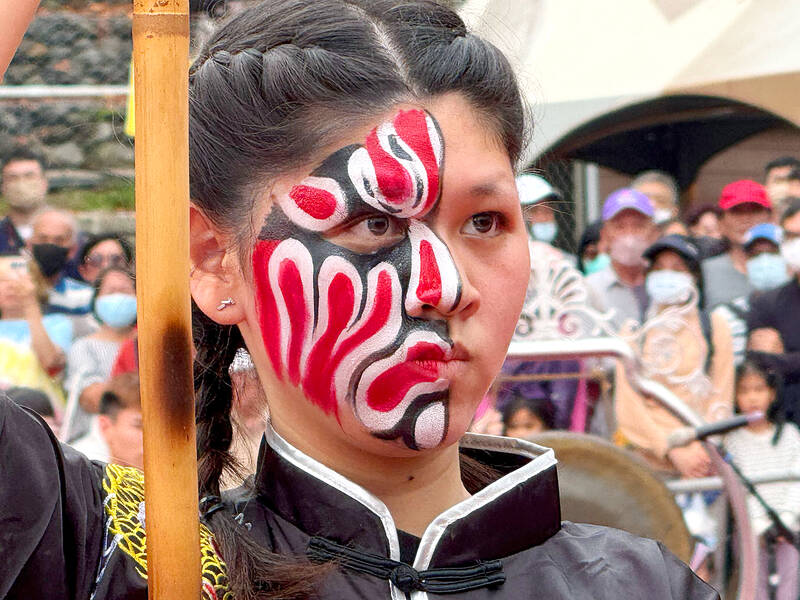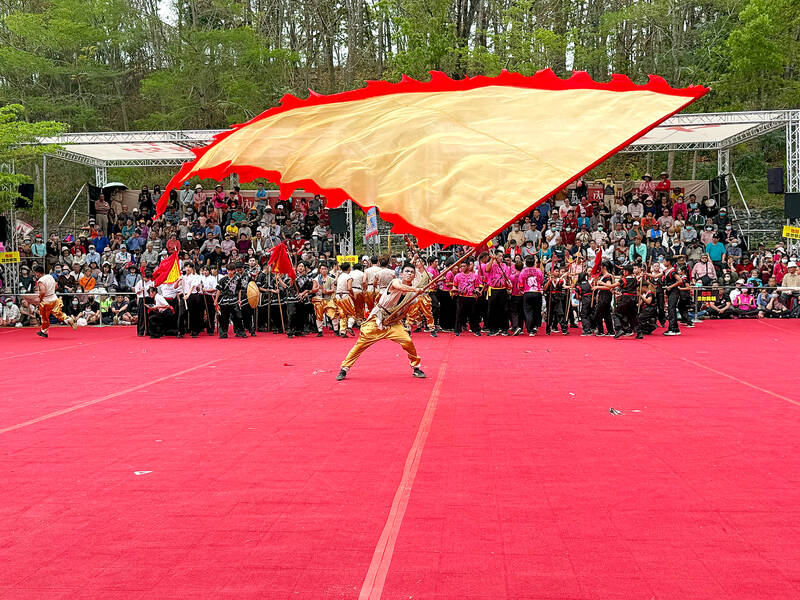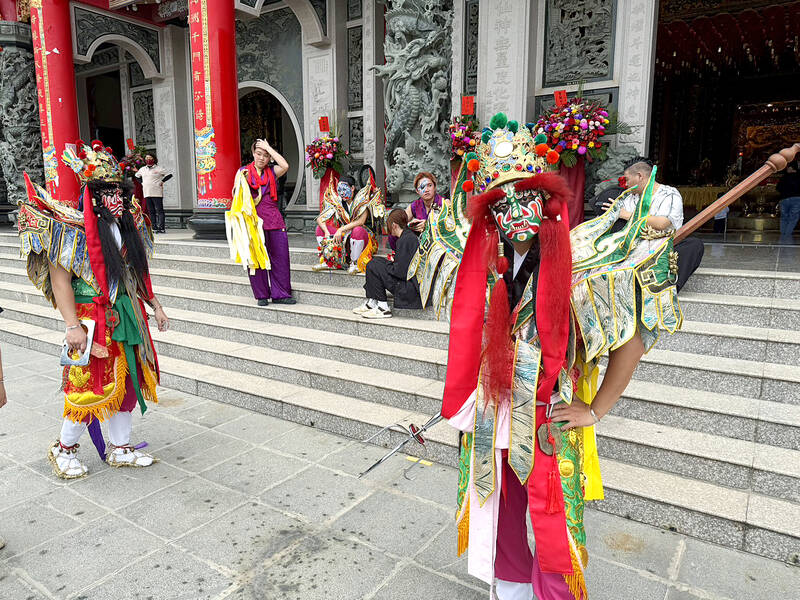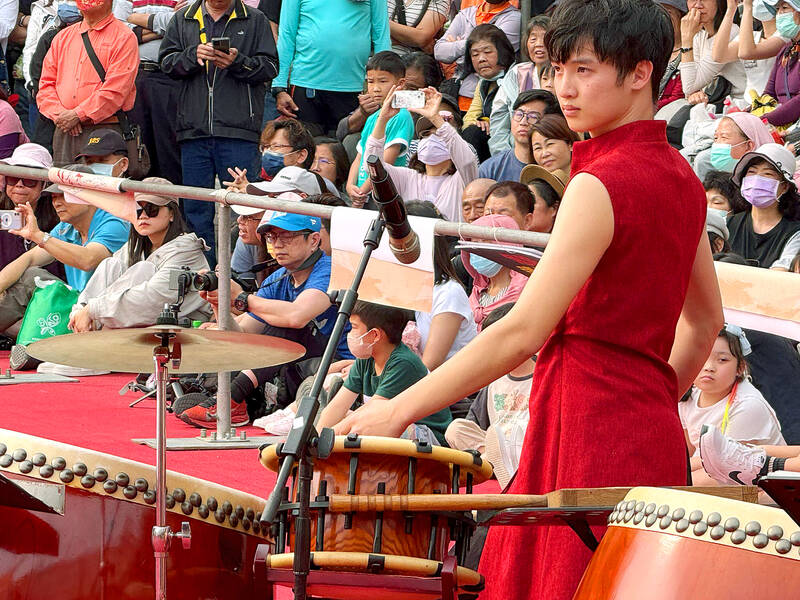Shunxian Temple (順賢宮) is luxurious. Massive, exquisitely ornamented, in pristine condition and yet varnished by the passing of time. General manager Huang Wen-jeng (黃文正) points to a ceiling in a little anteroom: a splendid painting of a tiger stares at us from above. Wherever you walk, his eyes seem riveted on you.
“When you pray or when you tribute money, he is still there, looking at you,” he says.
But the tiger isn’t threatening — indeed, it’s there to protect locals. Not that they may need it because Neimen District (內門) in Kaohsiung has a martial tradition dating back centuries.

Photo: Julien Oeuillet
On April 5, Shunxian Temple hosted the Neimen Songjiang Battle Ritual, a yearly competition that combines choreographed martial arts and traditional theater.
MARTIAL TRADITION
The Songjiang Battle Ritual is a deeply Taiwanese tradition and stems from the region’s history of irredentism and local resistance to outside rule.

Photo: Julien Oeuillet
Militias were first formed by speakers of Hokkien (commonly known as Taiwanese) villagers of the Neimen area to defend themselves against raids by the indigenous population and Han Chinese pouring in from Tainan, then the seat of the Qing Empire’s attempts at subjugating the island.
Later on, the Neimen warriors allied with one of the indigenous communities to push back on Qing forces. The ritual was thus born at the moment when the island grew an identity away from the common root of the ancient Sinosphere.
Despite its ages-old character, the Songjiang Battle Ritual is a celebration of juvenile passion, dedication and determination.

Photo: Julien Oeuillet
Each troop numbers around two dozen, mostly in their early twenties, telling a story through simulated fighting, with weapons or bare limbs.
Live and recorded music is constantly booming, while flag-bearers wave their colors, sometimes carrying gigantic banners. Not a word is uttered: their choreographed fights, screams, movements and props do the job.
HONORS

Photo: Julien Oeuillet
This year’s winning team, Fengwu Xinchuan-Xiluo Fengshan Pavilion (鳳武薪傳西螺鳳山館), used modern imagery to tell the story of folk hero Liao Tian-ding (廖添丁), a sort of Taiwanese Robin Hood celebrated for his resistance to Japanese rulers in the early 1900s.
For their efforts, the troupe, received honors from local officials, including Ho Kuo-jao (何國昭) a 101-year-old kung-fu master.
After the competition ends, the food stalls close up, and performers and the audience disperse. Inside the temple, a few late pilgrims come to pray to Matsu and the deity of martial artists, Guan Yu, all while the tiger continues to cast its protective gaze.

Photo: Julien Oeuillet

The People’s Republic of China (PRC) last week offered us a glimpse of the violence it plans against Taiwan, with two days of blockade drills conducted around the nation and live-fire exercises not far away in the East China Sea. The PRC said it had practiced hitting “simulated targets of key ports and energy facilities.” Taiwan confirmed on Thursday that PRC Coast Guard ships were directed by the its Eastern Theater Command, meaning that they are assumed to be military assets in a confrontation. Because of this, the number of assets available to the PRC navy is far, far bigger

The 1990s were a turbulent time for the Chinese Nationalist Party’s (KMT) patronage factions. For a look at how they formed, check out the March 2 “Deep Dives.” In the boom years of the 1980s and 1990s the factions amassed fortunes from corruption, access to the levers of local government and prime access to property. They also moved into industries like construction and the gravel business, devastating river ecosystems while the governments they controlled looked the other way. By this period, the factions had largely carved out geographical feifdoms in the local jurisdictions the national KMT restrained them to. For example,

The remains of this Japanese-era trail designed to protect the camphor industry make for a scenic day-hike, a fascinating overnight hike or a challenging multi-day adventure Maolin District (茂林) in Kaohsiung is well known for beautiful roadside scenery, waterfalls, the annual butterfly migration and indigenous culture. A lesser known but worthwhile destination here lies along the very top of the valley: the Liugui Security Path (六龜警備道). This relic of the Japanese era once isolated the Maolin valley from the outside world but now serves to draw tourists in. The path originally ran for about 50km, but not all of this trail is still easily walkable. The nicest section for a simple day hike is the heavily trafficked southern section above Maolin and Wanshan (萬山) villages. Remains of

Shunxian Temple (順賢宮) is luxurious. Massive, exquisitely ornamented, in pristine condition and yet varnished by the passing of time. General manager Huang Wen-jeng (黃文正) points to a ceiling in a little anteroom: a splendid painting of a tiger stares at us from above. Wherever you walk, his eyes seem riveted on you. “When you pray or when you tribute money, he is still there, looking at you,” he says. But the tiger isn’t threatening — indeed, it’s there to protect locals. Not that they may need it because Neimen District (內門) in Kaohsiung has a martial tradition dating back centuries. On